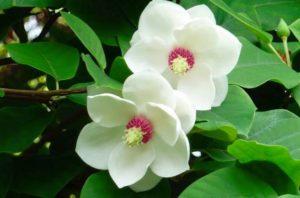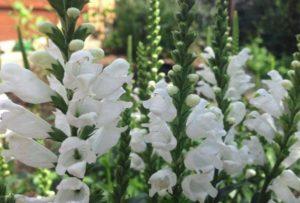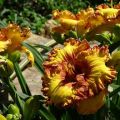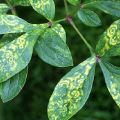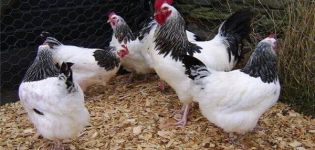Rules for growing and caring for fuchsia, especially breeding and wintering
Abundantly flowering indoor plants are especially loved by florists and hobbyists. Fuchsia, strewn with buds and flowers, can become a real decoration of the house, and in the summer - and a summer cottage flower bed. The refined shape, bright complex color of the petals make the culture popular with flower growers. Consider the features of growing and caring for fuchsia.
What is a plant?
Small fuchsia trees or shrubs were discovered in the Dominican Republic in the 17th century. Fúchsia was named after the German botanist L. Fuchs. Natural species are found in South and Central America, New Zealand.
A perennial plant belongs to the Fireweed family. About a hundred natural species of fuchsia are known. The decorative effect of the bush and the long, abundant flowering prompted the cultivation of the plant at home. Breeders have created many varieties that differ in a wide variety of shapes and colors of flowers.
A home plant is a bush with a straight or ampelous stem with flexible branches. The foliage is green or slightly red. The leaves are pointed, oppositely arranged. Fuchsia blooms for a long time, with a large number of buds. Flowers drooping, consist of a brightly colored calyx and a corolla. The petals are folded back. Forms an edible fruit.
Reference: magenta is called fuchsia. The bright, sophisticated shade invariably becomes a hit in many fashion collections.
Varietal varieties of fuchsia
From hundreds of natural fuchsia species, breeders have obtained many varieties and hybrids that differ in the shape of the stem and flowers. Plant lovers grow species and varieties in their dachas and apartments.

Fuchsia varieties are divided into several groups according to the shape of flowers and stems:
- ampelous;
- with simple colors;
- terry and semi-double;
- blooming brushes.
Popular varieties of fuchsia growing in a bush:
- Thalia - orange petals, three-leafed variety;
- Bright red - scarlet flowers adorn the house from April to October;
- Anabel is a cultivar with exquisite white flowers;
- Ballerina - medium-sized flowers combining pink and white and scarlet shades;
- Allison Patricia - small bush with medium-sized purple flowers for a small windowsill;
- Alisson Bell - red-purple buds turn into semi-double flowers;
- Dancing Flame - pink-orange semi-double flowers.
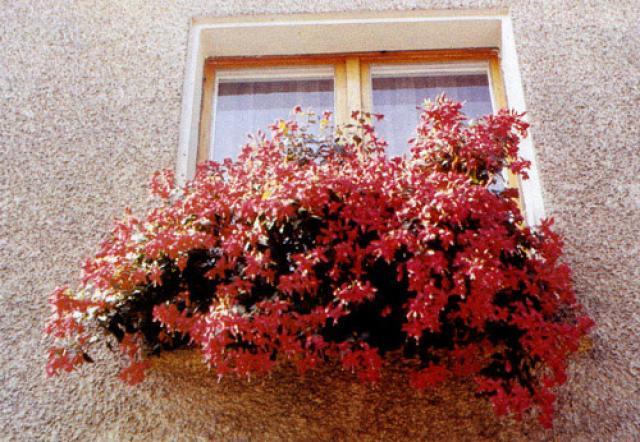
Ampel varieties with flexible stems falling down and an abundance of flowers are grown in pots:
- Blue Angel - a lilac flower on snow-white sepals, double;
- Bella Rosella - large-flowered variety, lush pink petals on a lilac bed;
- Cecile - semi-ample variety, lilac-violet skirt with pink sepals;
- Blue Vale - bluish-blue, with a pink base, petals on a white bed of the calyx.
Many varieties and hybrids have bush and ampelous forms.
Basic rules for growing a crop
To preserve varietal characteristics, fuchsia is grown from cuttings of an adult plant. So rooting and development is faster. All properties of the mother culture are transferred to the young plant in full.
Time and place
Cuttings are cut in the spring from an adult plant. Pottery pots are used for planting. It is important to remember that large containers for small plants are not taken. The size of the container increases as the bush grows. For planting a young cutting, a pot with a diameter of 9-10 centimeters is enough.
The fuchsia container is placed in a place protected from bright light for most of the day. Sun rays are allowed only in the morning or evening.
Preparation of planting material
For planting young fuchsia, choose a slightly hardened young stem of an adult culture with 2-3 buds, 10-20 centimeters long. Cutting is carried out with a sharp, clean instrument. Cut off all the lower leaves, leave 2-3 on top. For growing roots use:
- settled water;
- a mixture of sand and peat - the cutting is deepened by 1-1.5 centimeters.
From above, the container is covered with transparent film or glass. For rapid root growth, a temperature of 18-22 ° is sufficient.

The roots of the plant grow back in 5-10 days, they can be seen in the water. You should not delay the transplant for a long time, otherwise the long roots will be damaged during landing.
Landing technology
Fuchsia loves drained soils, so small shards or other material are poured into the bottom of the pot. It is better to buy the soil ready-made, disinfected. When self-preparing the soil, mix leafy soil, peat, sand, turf in equal parts. The culture has no special requirements for soils, the acidity of the soil is neutral.
A seedling with roots is planted in prepared and watered soil. Rooting occurs within 2-3 weeks, the seedling begins to actively grow.
Features of fuchsia care
Growing fuchsia requires compliance with a number of prerequisites, otherwise the bush will drop the buds and stop the growing season. It is important to follow certain rules during flowering and dormancy.
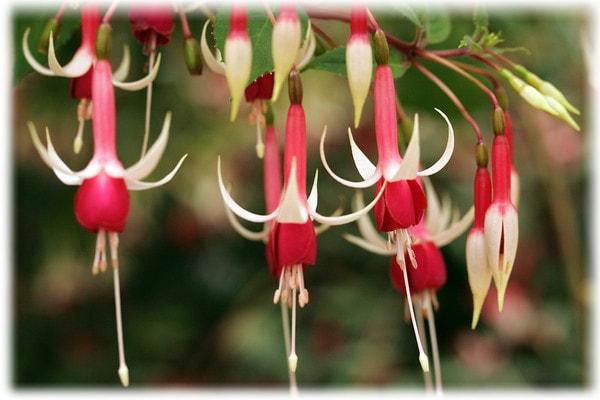
Temperature
Compliance with the temperature regime is the main difficulty in the cultivation of fuchsias. It is not easy to create comfortable conditions for a flower in an apartment environment. In the stage of active growth and flowering for the culture, it is necessary to maintain a temperature of 18-24 °. Excessive heat and direct sunlight is a common reason that fuchsia does not bloom, sheds buds, leaves turn yellow and wither. Wintering a flower requires even lower temperatures (8-10 °). It is also important to keep the humidity low during the resting stage.
Watering
Flowers are watered with soft, lukewarm water. Recommended watering scheme:
- during the growing season - 1-2 times a week;
- in autumn and winter - once every 2 weeks.
If the temperature in winter is above 10 °, water should be done more often. It is necessary to defend the water for at least a day, the earthen lump should not be dry or too wet. The water accumulated in the pan is drained.

Note: it is convenient to put the container with fuchsia on an elevation in the pallet so that excess water is not absorbed into the soil. Excess moisture, especially if the pot is too large and not all filled with roots, provoke rotting of the root system
Top dressing
The culture grows quickly, blooms profusely and for a long time. The vegetation should be supported by top dressing. They are carried out from March to September, with the transition of the plant to an inactive state, fertilizers are stopped.

Fundamental rules:
- when collecting green mass, nitrogen-containing fertilizers are required;
- during flowering - potassium and phosphorus.
In addition to the main elements, for the development of fuchsia, manganese, zinc, magnesium are needed. It is better to use special complex fertilizers with a verified composition. The frequency of fertilizing is a subject of special discussion for flower growers. Weekly or more frequent feeding is recommended. When fertilizing with each watering, the weekly rate is divided into several parts. In the absence of flowering, it is recommended to spray the bushes with stimulants (Zircon). Fertilizers are applied in the form of a solution, many growers dissolve fertilizing in water for irrigation.
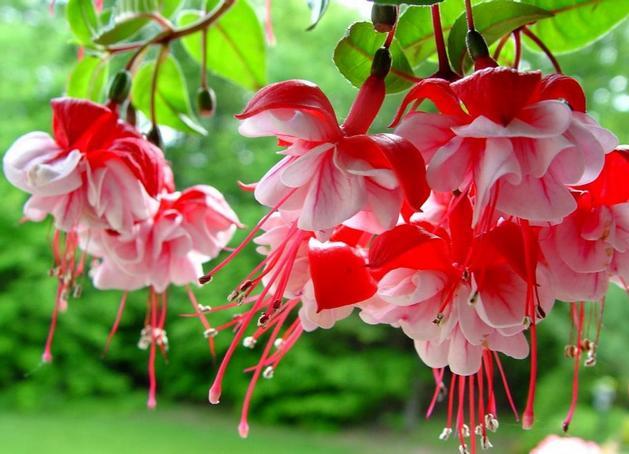
Transfer
Fuchsia does not like large pots and loose soil in containers, but grows quickly. The bush is transplanted annually - in the spring, when the culture has not yet completely moved away from winter dormancy. Choose a pot 4-5 centimeters larger than the previous one. Prepare the drainage layer and soil as in propagation. The bush is transplanted by the transshipment method, only slightly shaking off the soil. The earth ball is moved to a larger container without burying the plant. The voids in the pot are filled with fresh soil. The oldest branches are cut, the rest are shortened by a third.
Spill the lump well with water until the excess appears in the pan. Drain the water, put the pot in a shaded place. Plants tolerate transplantation well, please with abundant flowering.
Air humidity and spraying
Plants absorb water not only by the roots, but also by the stems and leaves. Fuchsias love high air humidity and need to be sprayed. Plants are moistened with a spray bottle in the absence of sunlight, the best time is morning and evening. When irrigating, it is important not to transfer the pot to another place, but to spray where the container is constantly. With the transition of the culture to an inactive stage of development (in autumn), spraying is reduced, in winter they stop altogether.

Trimming and pinching
Buds are formed on young shoots. Old branches are pruned to make room for new ones. Pruning is also used to form the desired bush shape, giving the plant the desired appearance.
Pinching slows down the growth of shoots, but stimulates flowering. Without pinching, the number of flowers will be less, and the bush will stretch upward.
Autumn pruning of fuchsia for the winter, after flowering is complete, is used to form a bush. You can cut woody branches in winter if the bush is in the apartment. In the spring, the bush is revised, the dead and excess processes are removed. Trimming the top growth points allows you to create a lush crown and stop the excessive upward pull of the plant.
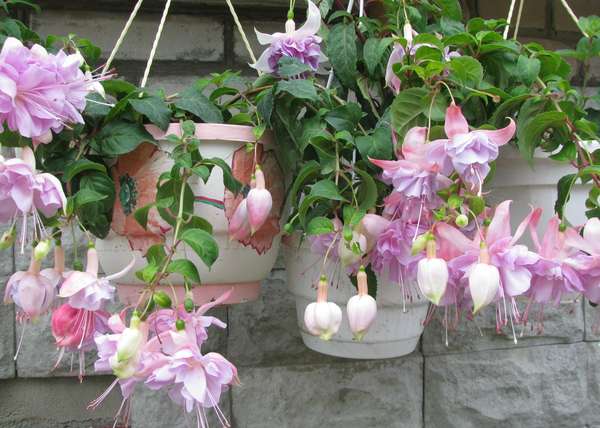
Winter care
A perennial plant needs a rest period, stopping the growing season. This happens in winter. Low-temperature conditions are created for the bushes, at this time all processes are suspended. Watering is minimized (once every 2 weeks). Horticultural crops in warm regions often hibernate directly in the open field. For them, shelters are created from spruce branches. Indoor plants need a significant decrease in temperature (5-10 °). Many flower growers send fuchsias to winter in a cellar or basement, if it is impossible to create the necessary conditions in the country or in the apartment. In most regions, fuchsias will freeze out in the garden.
Diseases and pests
The main diseases of fuchsia are associated with the wrong choice of irrigation scheme and living conditions. With an excess of moisture, fungal diseases of the roots and green part develop. For treatment, fungicides (Topaz) are used, they normalize illumination, watering, and temperature.

In hot dry weather, pests multiply - spider mites, whiteflies. It is important to regularly inspect the bushes in order to stop the growth of the population in time. For processing, folk remedies or insecticides are used.
Plant propagation
Fuchsia can multiply in two ways - vegetative and seeds. Getting your own seeds is a painstaking and complicated business.When grown from seed, maternal properties are rarely preserved. The seed is used by breeders for work.
The vegetative method is more reliable and shorter. Cuttings and leaves are used to obtain young plants. Subject to the basic rules of care, young fuchsias retain all the features of the parent specimen.
Possible problems
There are many difficulties in growing fuchsia. You need to take care of the plant all year round. Several probable problems and their solutions:
- Fuchsias do not tolerate wintering in apartments. A good option is a glazed and insulated loggia without heating. You can hide the bush in a foam box.
- Fuchsia does not bloom. The reason may be too high the temperature in winter - the growing season did not stop, the plant has no strength for the buds. Top dressing is required. The use of growth stimulants that are sprayed on the bushes helps to increase the number of buds.
- Leaves wither and turn yellow. You need to find a place with a lower temperature, organize proper watering.
- Drops the buds. The plant does not like a change of place, even a simple turn with the other side to the light is difficult. Often the fall of buds is associated with overheating of the roots and high temperatures in the room.
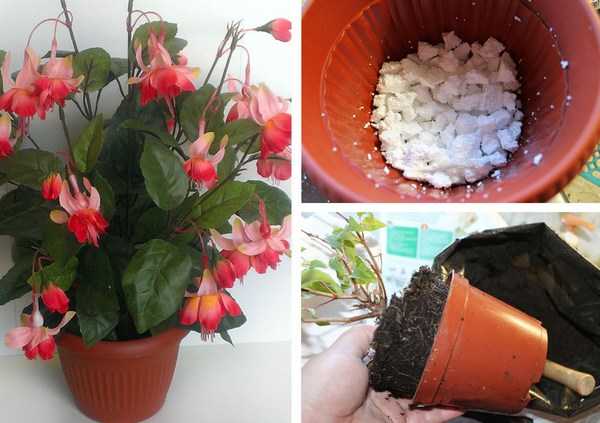
For any problems, watering, care is normalized, the bush is checked for pest infestation.
When growing fuchsia, it is important to follow all recommendations regarding temperature conditions, irrigation rates, timely transplantation into large containers. If you follow these rules, fuchsia will delight you with a sea of flowers that will decorate your house or garden area from spring to early autumn.
